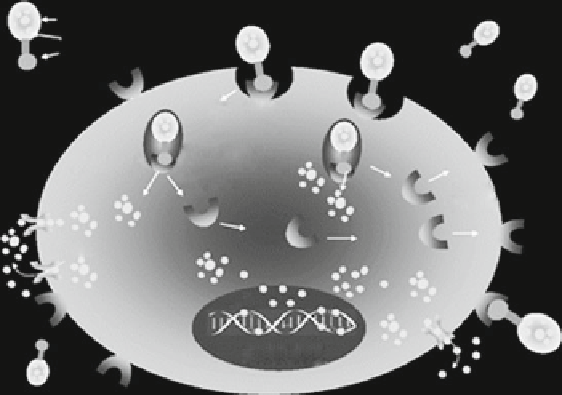Biomedical Engineering Reference
In-Depth Information
trials for the treatment of cancer. One of the reasons for this is that the number of
drug molecules that can be loaded on the antibody while preserving its immune
recognition is limited.
7.2.1
Internalization of Targeted Conjugates
Whether targeted conjugates can be internalized after binding to target cells is an
important criterion in the selection of proper targeting ligands. Internalization
usually occurs via receptor-mediated endocytosis. Using the example of the folate
receptor (Fig.
29
), when a folate-targeted conjugate binds with a folate receptor on
the cell surface, the invaginating plasma membrane envelopes the complex of the
receptor and ligand to form an endosome. Newly formed endosomes are transferred
to target organelles. As the pH in the interior of the endosome becomes acidic and
lysozymes are activated the drug is released from the conjugate and enters the
cytoplasm, provided the drug has the proper physico-chemical properties to cross
the endosomal membrane. Released drugs are then trafficked by their target organ-
elle, depending on the drug. Meanwhile, the folate receptor released from the
conjugate returns to the cell membrane to start a second round of transport by
binding with new folate-targeted conjugates. Some examples of different types of
nanocarriers for drug delivery systems are shown in Fig.
30
.
Carrier
Drug
Ligand
Receptor
Membrane
lnvagination
Drug release
triggered by pH or
enzymes
endosome
Exocytosis and
receptor recycling
MDR
DNA
Nucleus
Fig. 29 Internalization of nanoparticles via receptor-mediated endocytosis. Tumor-specific
ligands or antibodies on the nanoparticles bind to cell-surface receptors, which trigger internaliza-
tion of the nanoparticles into the cell through endosome. As the pH in the interior of the endosome
becomes acidic, the drug is released from the nanoparticles and goes into the cytoplasm. Drug-
loaded nanoparticles bypass the P-glycoprotein efflux pump, not being recognized when the drug
enters cells, leading to high intracellular concentration.
MDR
multidrug resistance. (Adapted from
[
107
])

